On June 17, 2024, lightning sparked the South Fork Fire on the Mescalero Apache Reservation near Ruidoso, New Mexico. The blaze spread quickly, forcing the evacuation of Ruidoso just hours after ignition. Over the next month, the fire burned more than 7,000 hectares and destroyed over 1,400 structures, leaving a lasting impact on the region.
While wildfires are a natural part of many ecosystems, they are notoriously difficult to manage and can pose severe threats to nearby communities. The South Fork Fire offers an opportunity to explore the effects of a large wildfire in a landscape of mixed conifer forests, piñon-juniper woodlands, and rapidly expanding wildland-urban areas.
For this project, I focused on mapping and analyzing burn severity within the fire region to better understand patterns of impact and the potential challenges for ecological and community recovery.
Study area, tools, and data sources
This analysis combined satellite imagery and spatial datasets to assess burn severity in the South Fork Fire.
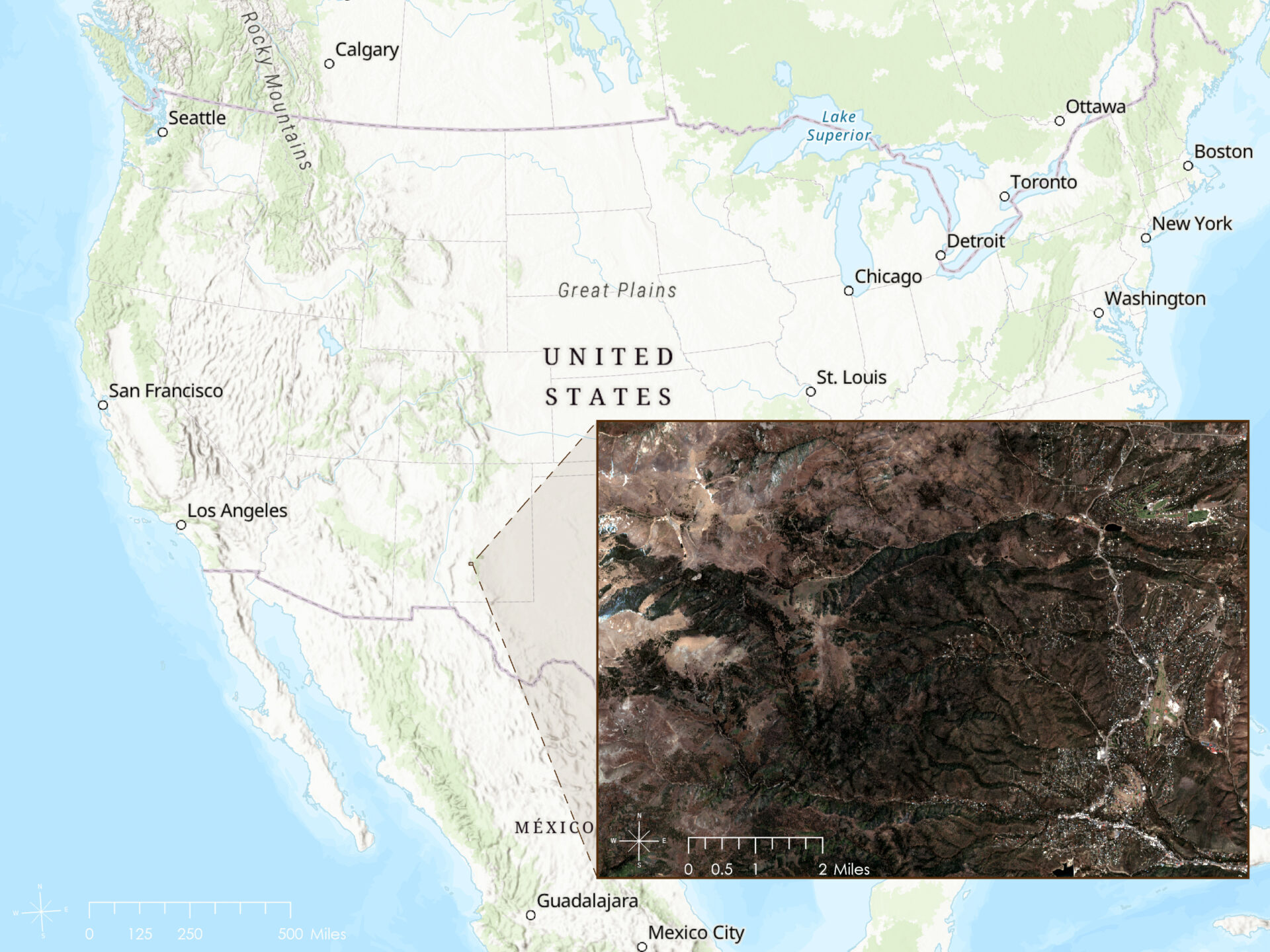
On the same day the South Fork Fire began, the nearby Salt Fire ignited just a dozen miles south of Ruidoso, ultimately burning over 3,000 hectares. The cause of that fire remains under investigation. Because of these neighboring fires and the history of wildfire in the area, I carefully defined the South Fork Fire region of interest to ensure the analysis focused on the correct perimeter and avoided mixed signals from other events.
Because authoritative perimeter data is not yet available in the Monitoring Trends in Burn Severity (MTBS) or Fire Information for Resource Management System (FIRMS) datasets, I extracted the burn perimeter from the National Interagency Fire Center’s WFIGS Current Interagency Fire Perimeters feature service and uploaded it into Google Earth Engine as a shapefile.
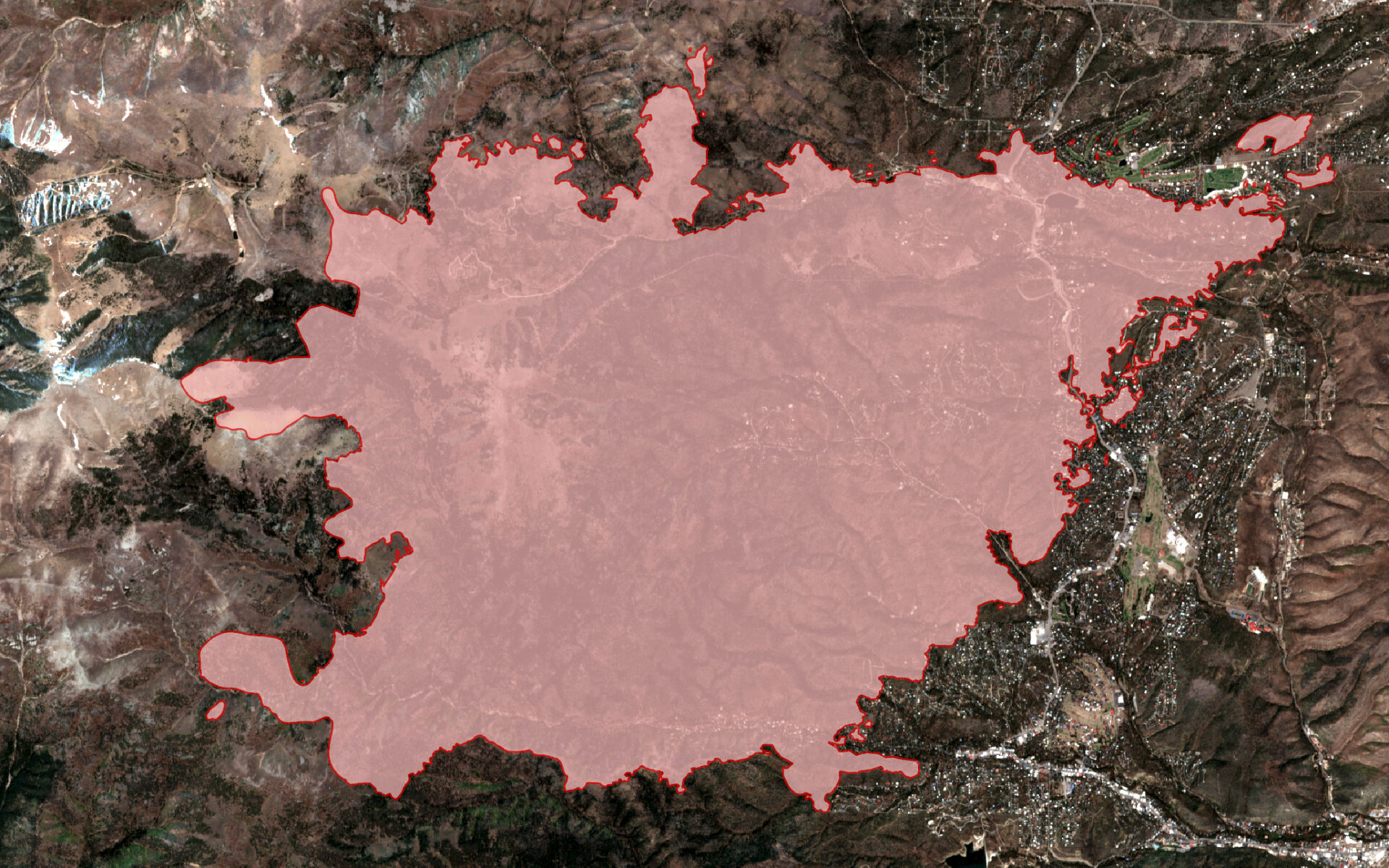
Satellite image processing, Normalized Burn Ratio (NBR) calculations, and burn severity classifications were carried out using Harmonized Sentinel-2 MSI Level-2A imagery accessed through Google Earth Engine. Additional layers included land cover data from Dynamic World, population density from the Global Human Settlement Layer, and active fire detections from FIRMS.
Statistical summaries (histograms, bar plots, correlation plots) were conducted in R Studio, while final mapping outputs were prepared in ArcGIS Pro. Beyond mapping burn severity, my goal was to begin exploring how factors like vegetation type and terrain may have influenced fire behavior and impacts on the landscape.
Pre- and post-fire images
The first step in the analysis was to define the study area, acquire multi-temporal Sentinel-2 image collections from before and immediately after the fire, crop them to the region of interest, apply scaling factors, mask out clouds (imagery was filtered to include only scenes with less than 1% cloud cover, and an additional cloud mask was applied for consistency), and generate median composites from the image stacks.
Example JavaScript code snippet in Google Earth Engine (GEE) to illustrate this step:
// Create pre-fire image collection
var prefireRawImCol = ee.ImageCollection("COPERNICUS/S2_SR_HARMONIZED")
.filterDate(prefire_start, prefire_end)
.filterBounds(roi)
.filterMetadata('CLOUDY_PIXEL_PERCENTAGE', 'less_than', 1);
// Print the number of images that match the filtering in the console
prefireRawImCol.size().evaluate(function(count) {
print('Number of pre-fire images after filter:', count);
});
// Create post-fire image collection
var postfireRawImCol = ee.ImageCollection("COPERNICUS/S2_SR_HARMONIZED")
.filterDate(postfire_start, postfire_end)
.filterBounds(roi)
.filterMetadata('CLOUDY_PIXEL_PERCENTAGE', 'less_than', 1);
// Print the number of images that match the filtering in the console
postfireRawImCol.size().evaluate(function(count) {
print('Number of post-fire images after filter:', count);
});
// Create scaled & cloud-masked image collections
var prefireImCol = prefireRawImCol.map(applyScaleFactors);
var postfireImCol = postfireRawImCol.map(applyScaleFactors);Next, band combinations were created for visual interpretation. The natural color composite (RGB: 4-3-2 in Sentinel-2 bands) approximates what the landscape would look like to the human eye.
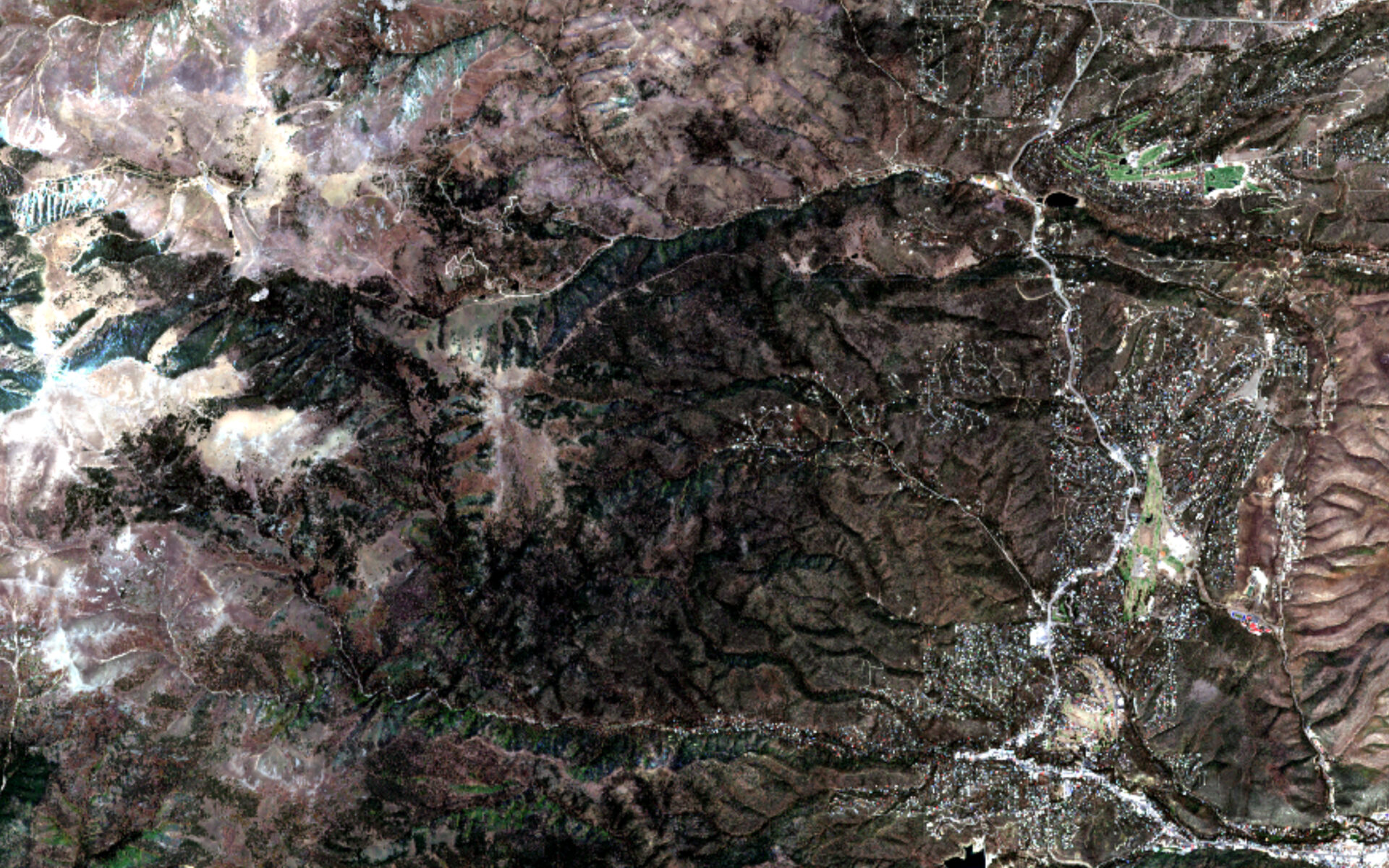
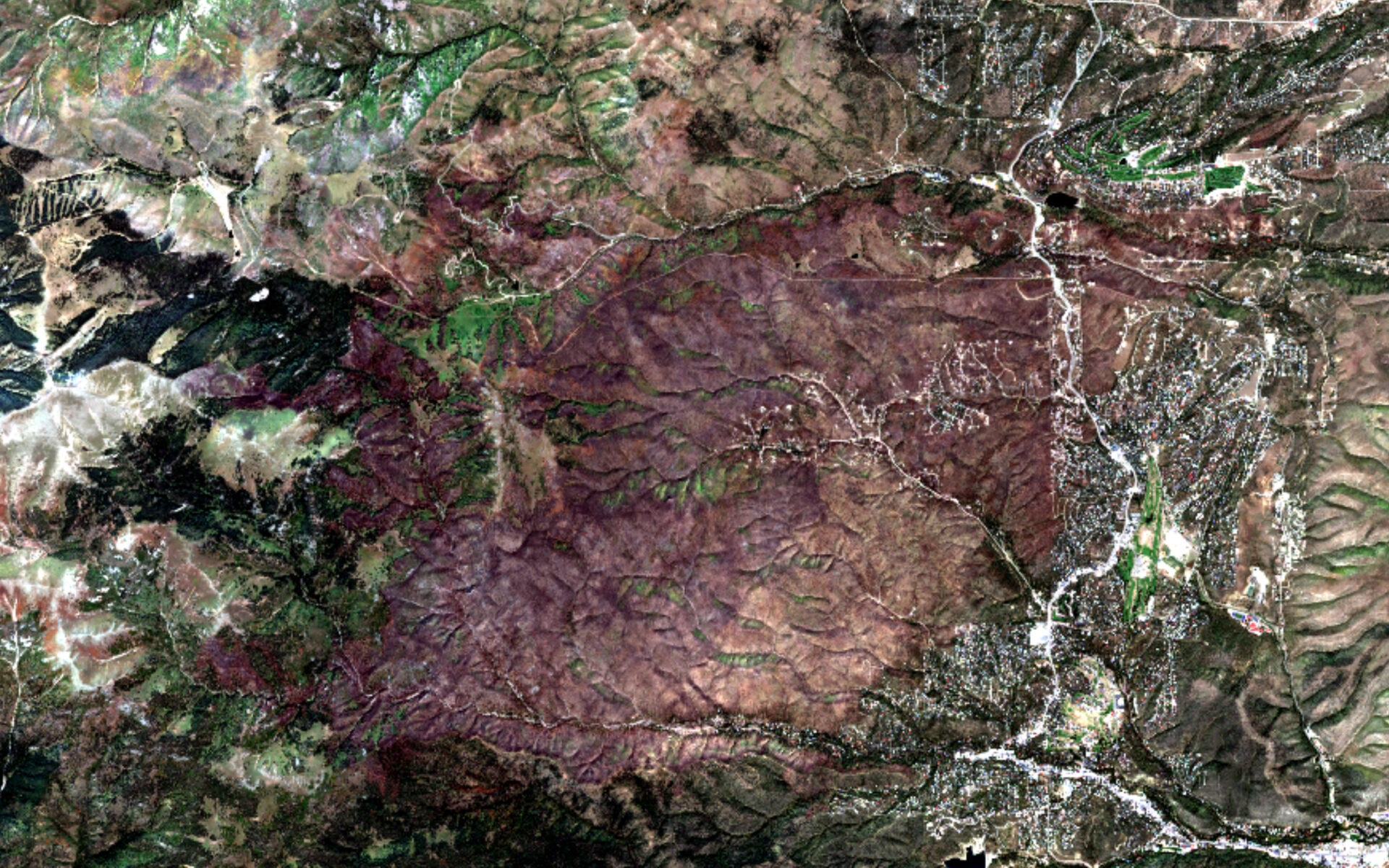
To better highlight vegetation conditions and fire impacts, I also generated color infrared (CIR) composites, which assign near-infrared (NIR), red, and green bands to the visible display channels. This visualization helps distinguish healthy from damaged vegetation.
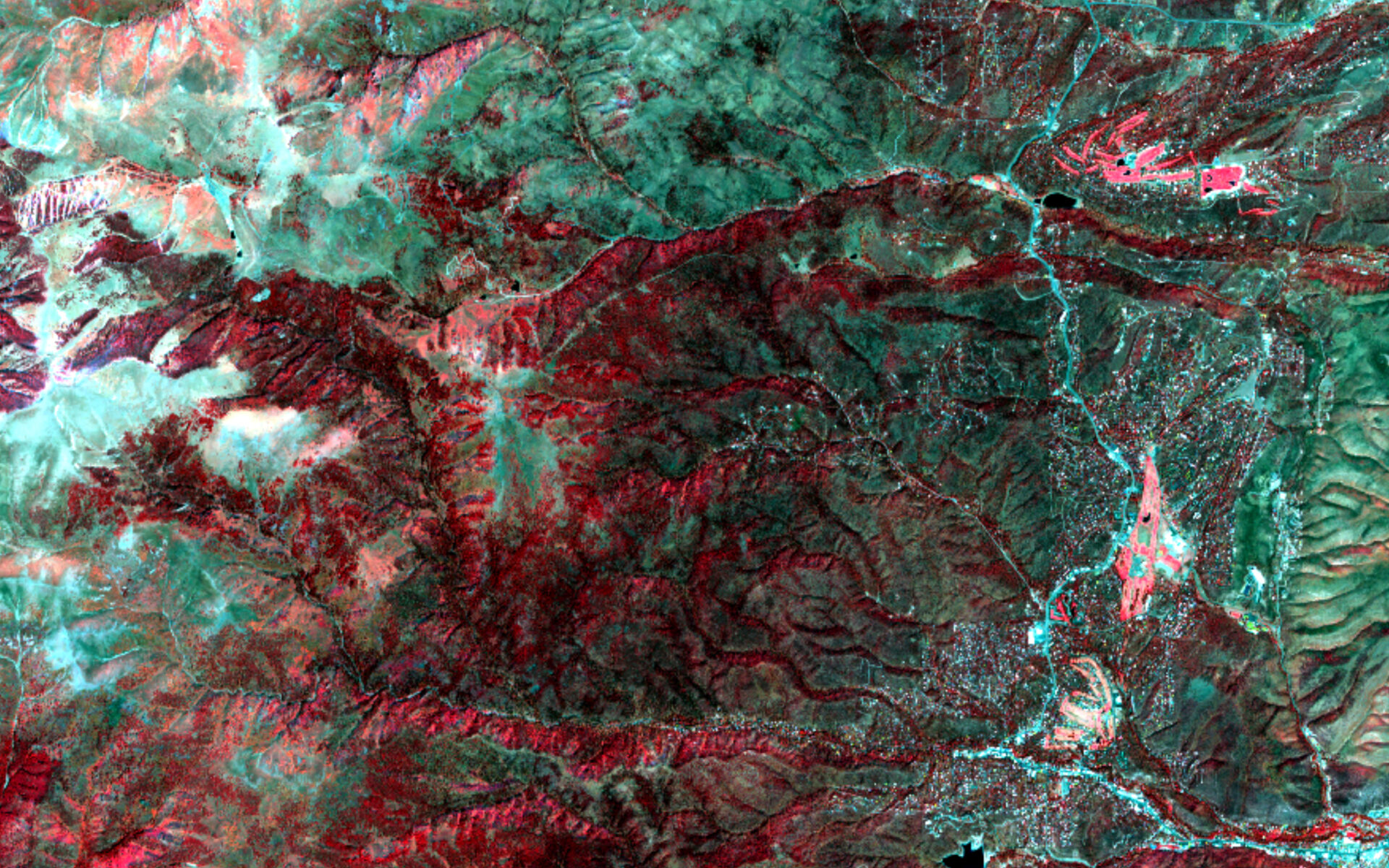
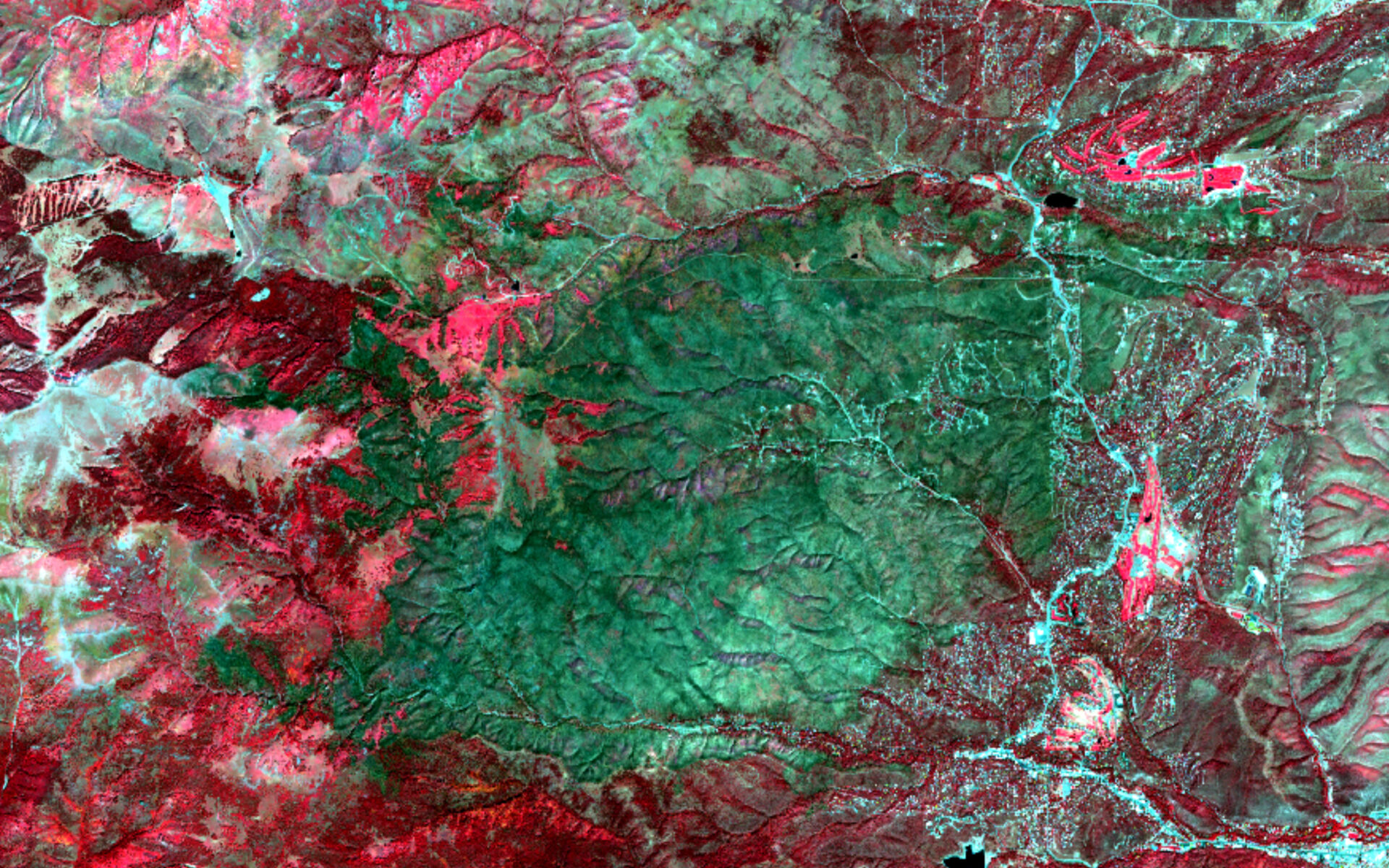
In CIR images, healthy vegetation appears bright red; stressed or sparse vegetation shows as light red or pink; and burned or barren areas appear dark green or black. CIR composites sharply delineate the burn scar, clearly revealing the extent and severity of vegetation loss.
Harmonized Sentinel-2 MSI Level-2A imagery has already been atmospherically and radiometrically corrected to surface reflectance, which reduces the need for additional preprocessing steps like radiometric normalization.
For this project, I chose not to apply topographic correction because differenced indices (such as dNBR and RdNBR) are calculated using paired pre- and post-fire images under similar sun angles and illumination conditions. This relative change detection approach reduces the influence of topography, making additional terrain normalization unnecessary.
Burn severity calculations using NBR and RdNBR
Burned areas have a distinct spectral signature that separates them from healthy vegetation. While healthy vegetation strongly reflects NIR light, burned or charred surfaces reflect more in longer wavelengths like short-wave infrared (SWIR). The Normalized Burn Ratio (NBR) helps capture this contrast and is commonly used to analyze fire impacts.
Applying NBR to the South Fork Fire area reveals the burn scar clearly.
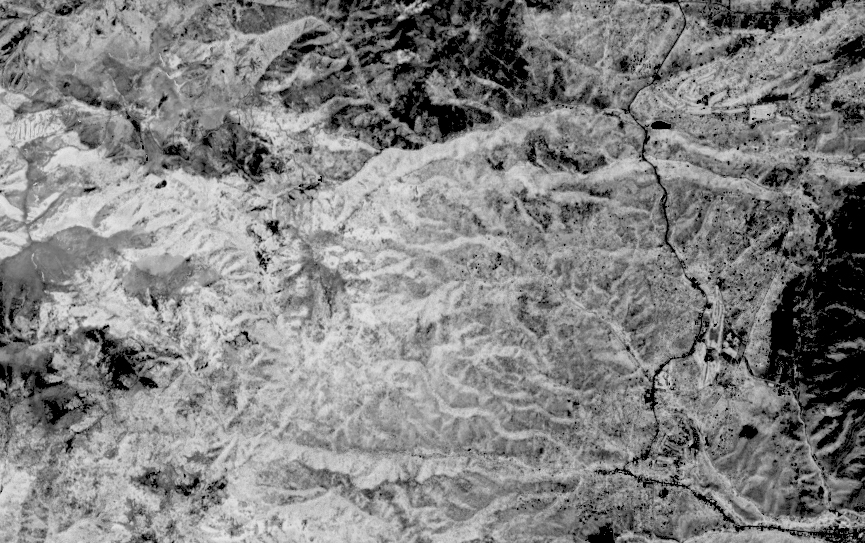

NBR values range between -1 and 1. To interpret these values, I generated pre- and post-fire NBR histograms showing the distribution of vegetation density before and after the fire.
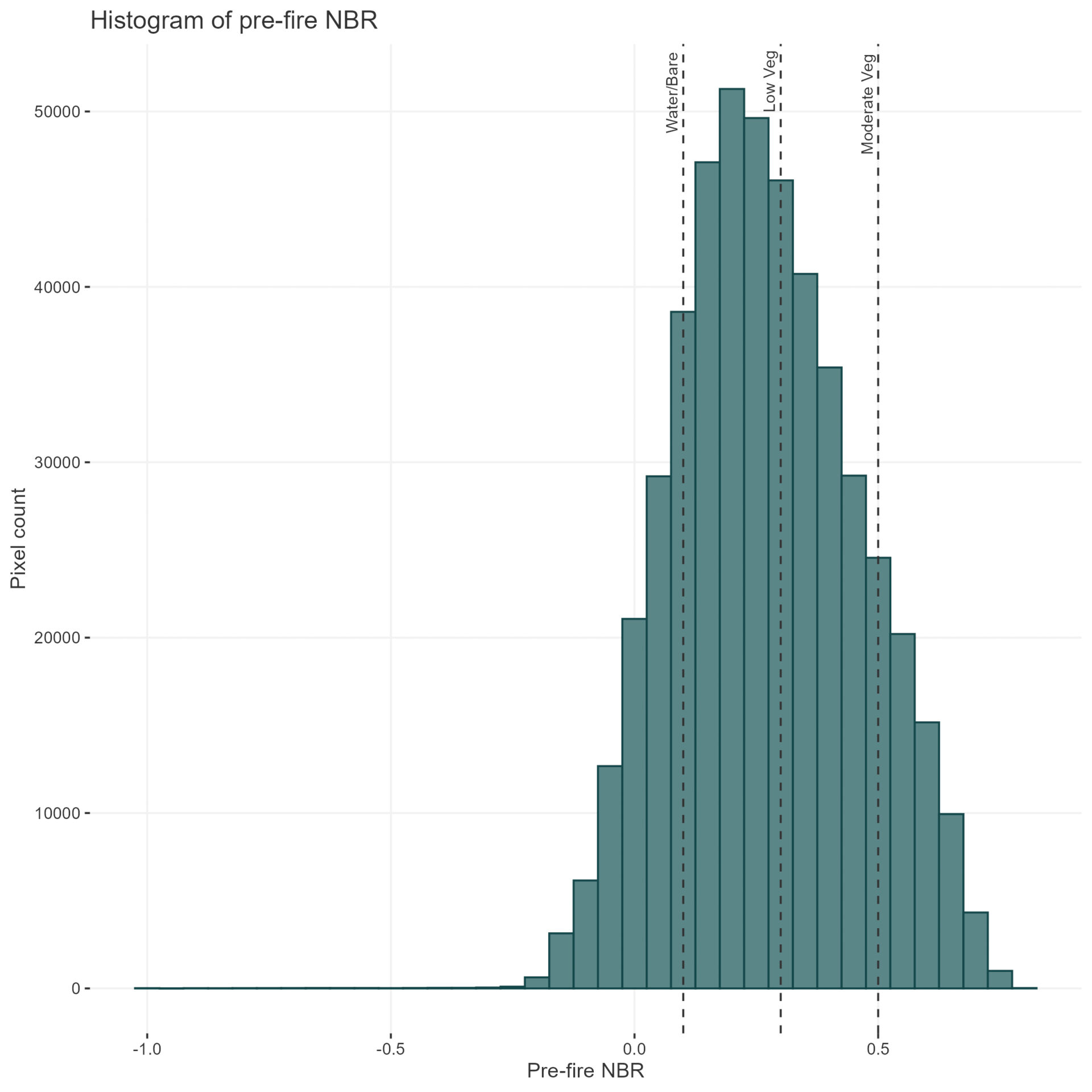

The general interpretation of NBR values is:
| NBR range | Interpretation |
| < 0.1 | Water / bare ground |
| 0.1–0.3 | Low vegetation |
| 0.3–0.5 | Moderate vegetation |
| > 0.5 | High vegetation cover |
The pre-fire histogram is skewed toward higher (positive) values, reflecting healthy vegetation cover, whereas the post-fire histogram shows a marked shift toward lower values, indicating the loss of vegetation following the fire.
While NBR gives a snapshot of vegetation conditions at a single moment in time, measuring the change between pre- and post-fire conditions allows us to assess burn severity more directly. The differenced Normalized Burn Ratio (dNBR), calculated as the pre-fire NBR minus post-fire NBR, is a standard metric for this purpose.
However, because the Mescalero Apache Reservation and Ruidoso area include a mix of dense forests, shrublands, and grasslands, I was concerned that the dNBR calculation might overestimate severity in areas with naturally low pre-fire vegetation, such as grasslands or sparse shrublands. To address this, I used the Relative differenced Normalized Burn Ratio (RdNBR), which divides dNBR by the square root of the absolute value of the pre-fire NBR. This normalization reduces bias from pre-fire vegetation differences, improving the reliability of severity mapping across heterogeneous landscapes.

The RdNBR histogram shows a pronounced right-hand tail, extending beyond the moderate severity class, indicating a substantial amount of high-severity burn within the region. By applying standardized burn severity thresholds (following Miller & Thode, 2007), I generated a classified RdNBR map that provides a clearer, more interpretable assessment of burn severity.

Burn severity by land cover class
I compared Dynamic World with ESA WorldCover and found Dynamic World provided a better match for my timeframe and the spatial resolution needed for this relatively small study area. All subsequent analyses were conducted using the Dynamic World data.

Land cover data was obtained from Google’s Dynamic World V1 dataset, which includes its own global accuracy reporting. As a result, the classifications reflect published methods and products rather than newly trained or customized models requiring validation.

To explore how burn severity was distributed across land cover types, I calculated the total area, burned area, and percentage burned for each class.
| Class | Total area (hectares) | Burned area (hectares) | Percent burned |
| Bare ground | 541.2 | 47.0 | 9% |
| Crops | 435.0 | 168.8 | 39% |
| Flooded vegetation | 139.5 | 25.2 | 18% |
| Grass | 256.7 | 23.8 | 9% |
| Shrub & scrub | 10,839.0 | 4,956.8 | 46% |
| Trees | 4,175.8 | 889.2 | 21% |
| Urban area | 3,025.8 | 315.8 | 10% |
| Water | 22.4 | 7.4 | 33% |
The normalized burn summary revealed striking differences in how land cover types were affected by the South Fork Fire.
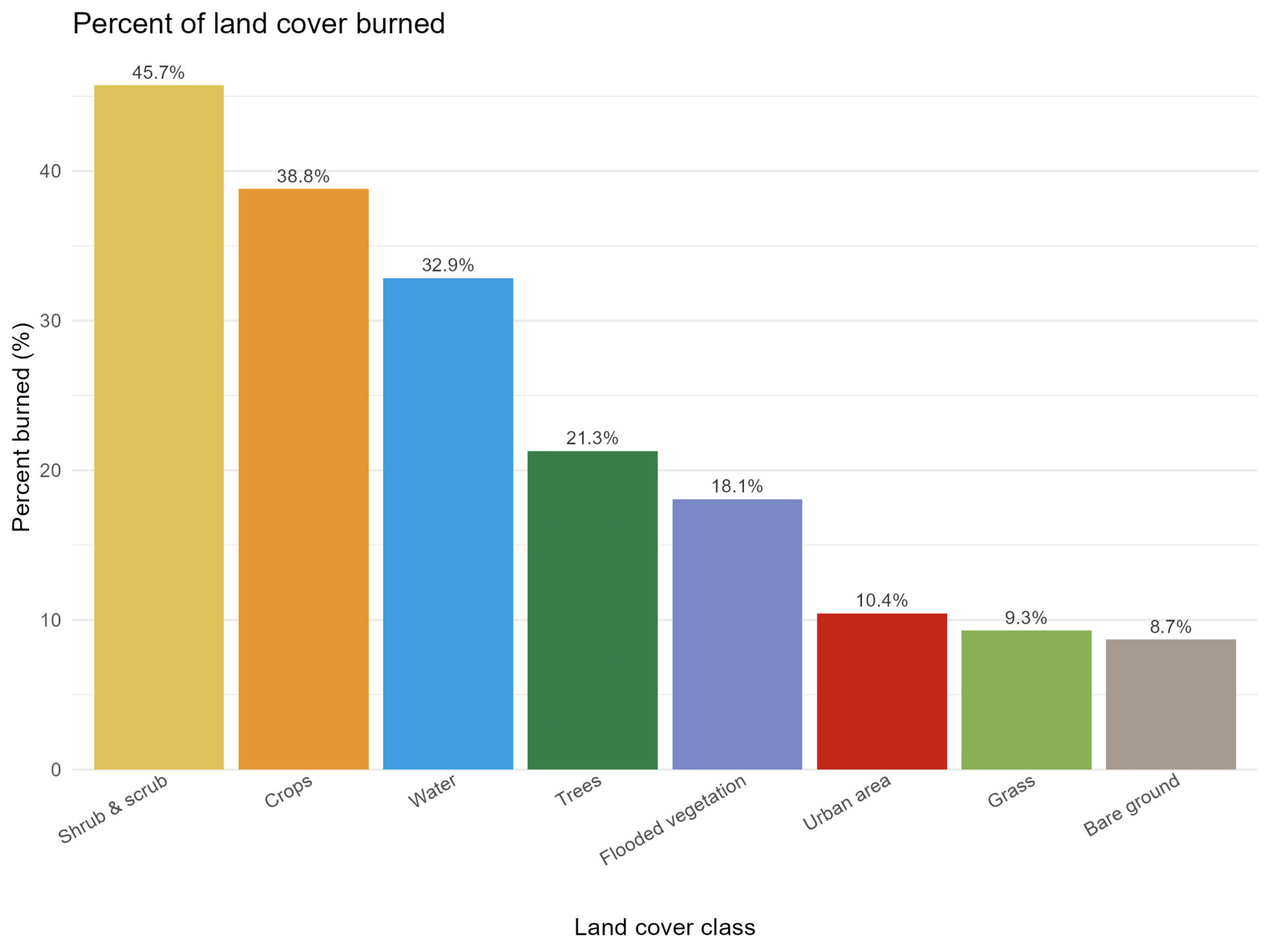
Shrub and scrub areas experienced disproportionately high levels of burn severity compared to other classes, suggesting potentially slower recovery and greater management needs in those regions. Urban areas, while making up a smaller share of the total area, still experienced measurable burning, with impacts concentrated in low to moderate severity classes.
Fire impact on vegetation
To assess how pre-fire vegetation influenced burn severity, I examined changes in the Normalized Difference Vegetation Index (NDVI), a widely used indicator of vegetation greenness and health.
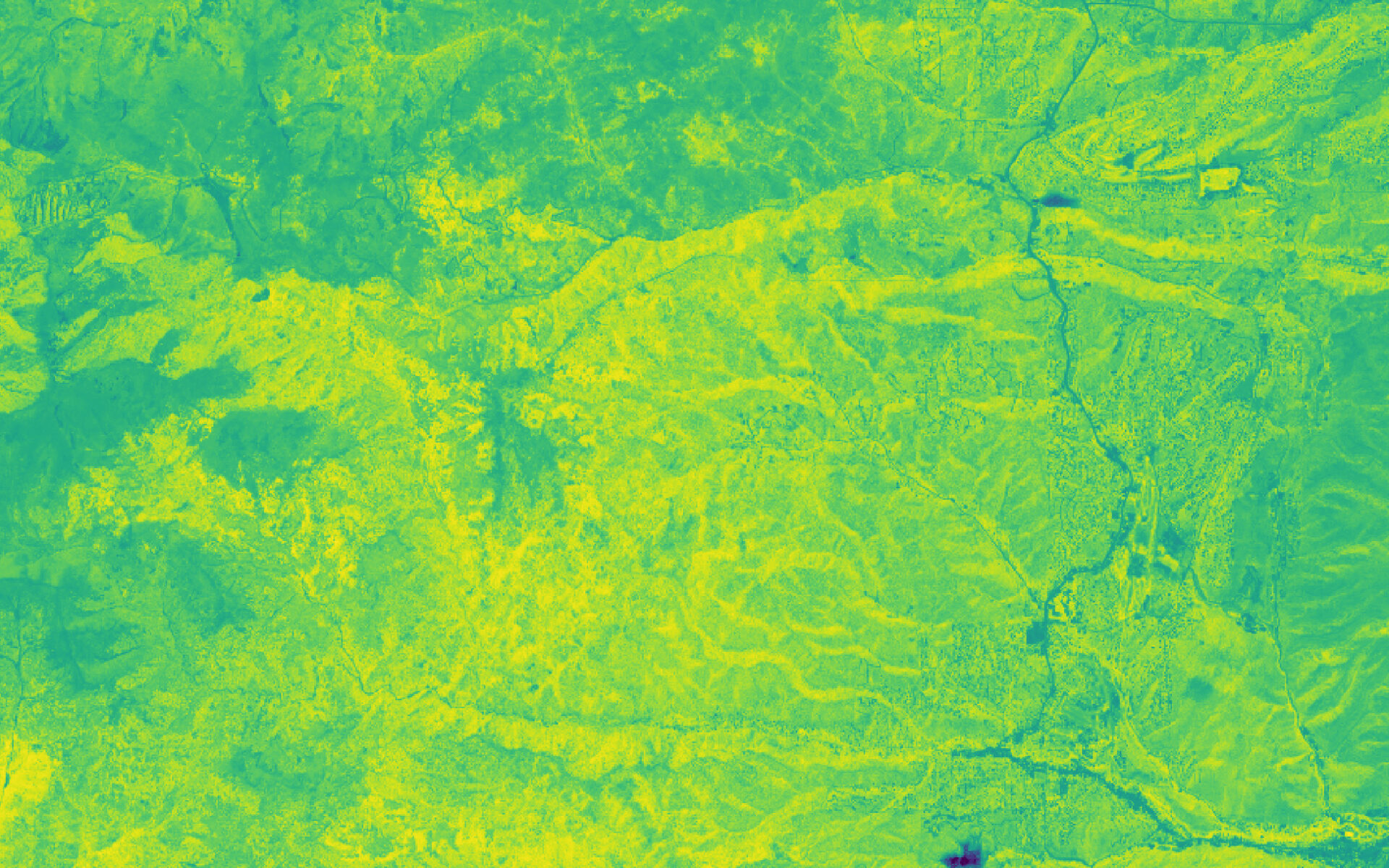

To quantify relationships between vegetation conditions and fire effects, I generated scatterplots comparing pre-fire NDVI to RdNBR values. NDVI provides a measure of pre-fire vegetation health, while RdNBR captures the severity of fire-induced change.

These plots visualize whether areas with denser or healthier vegetation experienced greater fire impacts. Correlation analysis showed a moderate positive relationship (r = 0.42), indicating that areas with higher pre-fire vegetation cover tended to experience somewhat greater burn severity.
Burn severity analysis and impact
Using the Miller & Thode RdNBR burn severity classes and GHSL: Global population surfaces data, I calculated a total of 6,862 hectares of burned area that impacted approximately 996 residents in the Ruidoso area.
This analysis raises several key questions for understanding the South Fork Fire’s ecological and community impacts:
Which land cover types burned most severely?
Shrub and scrub areas were the most heavily impacted, followed by crops and forested areas.
How has vegetation recovery varied by topography and pre-fire vegetation class?
While this project focused on immediate post-fire conditions, future analysis could assess whether slopes, aspect, or elevation influenced recovery rates across different land cover types.
What are the implications for regeneration and management?
High-severity burns in forested areas may require active intervention to support regeneration, while urban-wildland interfaces will need targeted mitigation efforts to reduce future wildfire risk.
Conclusion and future work
This assessment provides an early snapshot of the South Fork Fire’s burn severity and landscape impacts. However, long-term monitoring will be critical to understanding vegetation recovery and ecosystem resilience.
In the months and years to come, additional satellite imagery — preferably from the same season to minimize phenological variation — should be analyzed to track changes in vegetation indices such as NBR and NDVI. By comparing post-fire conditions over the next one to five years, it will be possible to quantify patterns of regrowth and assess how recovery differs across land cover types and topographic gradients.
These longitudinal analyses could help identify areas of slow recovery, inform post-fire management and restoration efforts, and improve our understanding of wildfire resilience in the South Fork Fire landscape.
Citations
European Space Agency (ESA). (2015). COPERNICUS/S2_SR_HARMONIZED: Harmonized Sentinel-2 MSI: MultiSpectral Instrument, Level-2A (Surface Reflectance) [Data set]. Google Earth Engine. https://developers.google.com/earth-engine/datasets/catalog/COPERNICUS_S2_SR_HARMONIZED.
Google. (2022). GOOGLE/DYNAMICWORLD/V1 [Data set]. Google Earth Engine. https://developers.google.com/earth-engine/datasets/catalog/GOOGLE_DYNAMICWORLD_V1.
NASA. (2022). FIRMS: Fire Information for Resource Management System [Data set]. Google Earth Engine. https://developers.google.com/earth-engine/datasets/catalog/FIRMS.
National Interagency Fire Center (NIFC). (2024). Current Interagency Fire Perimeters (WFIGS) [Data set]. National Interagency Fire Center Open Data. https://data-nifc.opendata.arcgis.com/datasets/nifc::wfigs-current-interagency-fire-perimeters/about.
NASA Applied Remote Sensing Training Program (ARSET). (2022). Mapping burn severity using remote sensing data in Google Earth Engine [Online tutorial]. https://appliedsciences.nasa.gov/what-we-do/capacity-building/arset.
U.S. Forest Service. (2006). Remote sensing methods for burn severity mapping [Fact sheet]. https://www.fs.usda.gov/rm/pubs/rmrs_gtr164.pdf.
U.S. Forest Service. (2024). South Fork and Salt fires incident information. InciWeb. https://inciweb.wildfire.gov/incident-information/nmmea-south-fork-and-salt.
U.S. Geological Survey. (2017). Burn severity and severity classification [Web page]. Monitoring Trends in Burn Severity (MTBS). https://www.mtbs.gov/data-availability.
World Wildlife Fund (WWF). (2006). WWF/HydroSHEDS/v1/Basins/hybas_10 [Data set]. Google Earth Engine. https://developers.google.com/earth-engine/datasets/catalog/WWF_HydroSHEDS_v1_Basins_hybas_10.
European Commission, Joint Research Centre (JRC). (2023). JRC/GHSL/P2023A/GHS_POP [Data set]. Google Earth Engine. https://developers.google.com/earth-engine/datasets/catalog/JRC_GHSL_P2023A_GHS_POP.
Key, C. H., & Benson, N. C. (2006). Landscape assessment: Ground measure of severity, the Normalized Burn Ratio; and remote sensing of severity, the delta Normalized Burn Ratio. In D. C. Lutes (Ed.), FIREMON: Fire effects monitoring and inventory system (pp. LA1–LA51). U.S. Department of Agriculture, Forest Service, Rocky Mountain Research Station. Gen. Tech. Rep. RMRS-GTR-164-CD.
Miller, J. D., & Thode, A. E. (2007). Quantifying burn severity in a heterogeneous landscape with a relative version of the delta Normalized Burn Ratio (dNBR). Remote Sensing of Environment, 109(1), 66–80. https://doi.org/10.1016/j.rse.2006.12.006.